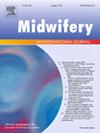Translation, cross-cultural adaptation, and psychometric testing of the Young Pregnancy Stigma Scale (YPrSS-BI): Indonesian version
IF 2.6
3区 医学
Q1 NURSING
引用次数: 0
Abstract
Objective
To translate the Young Parent Stigma Scale (YPSS) into Bahasa Indonesia and adapt for pregnant adolescents to become Young Pregnancy Stigma Scale (YPrSS-BI). To evaluate the psychometric properties of the YPrSS-BI and determine the perceived stigma and related variables of pregnant adolescents.
Design
A cross-sectional validation study.
Setting
West Sumatra province, Indonesia.
Participants
Pregnant adolescents (n=184) aged 15–19 years old.
Methods
The YPSS was translated and modified as YPrSS-BI for cultural congruity using the procedure of Beaton et al. (2000). A convenience sample of pregnant adolescents in West Sumatra, Indonesia provided data for exploratory factor analysis.
Findings
A four-factor solution across 22 items was found to explain a total variance of 66.9% of the perceived stigma of pregnant adolescent women. Cronbach's alpha of the YPrSS-BI was satisfactory for the total scale (0.88), and adequate to excellent across the four factors (0.77–0.94).
Conclusion
The YPrSS-BI is a valid and reliable instrument to measure stigma perceived by pregnant Indonesian adolescents.
Implications for practice
Stigma, entangled with social and cultural burdens, can negatively impact physical and mental health of adolescents during pregnancy. Healthcare providers can use the YPrSS-BI to evaluate stigmatized feelings of pregnant girls and foster potential interventions to reduce stigma burden.
目的 将年轻父母成见量表(YPSS)翻译成印尼语,并针对怀孕青少年进行调整,使之成为年轻怀孕成见量表(YPrSS-BI)。评估 YPrSS-BI 的心理测量学特性,并确定怀孕青少年感知到的耻辱感和相关变量。对印度尼西亚西苏门答腊怀孕少女的方便抽样调查为探索性因子分析提供了数据。结果发现,22 个项目的四因子解解释了怀孕少女感知到的耻辱的总方差为 66.9%。YPrSS-BI的Cronbach's alpha对总量表(0.88)和四个因子(0.77-0.94)的Cronbach's alpha都令人满意。医疗服务提供者可使用 YPrSS-BI 评估怀孕少女的耻辱感,并促进潜在的干预措施,以减轻耻辱负担。
本文章由计算机程序翻译,如有差异,请以英文原文为准。
求助全文
约1分钟内获得全文
求助全文
来源期刊

Midwifery
医学-护理
CiteScore
4.50
自引率
7.40%
发文量
221
审稿时长
13.4 weeks
期刊介绍:
Midwifery publishes the latest peer reviewed international research to inform the safety, quality, outcomes and experiences of pregnancy, birth and maternity care for childbearing women, their babies and families. The journal’s publications support midwives and maternity care providers to explore and develop their knowledge, skills and attitudes informed by best available evidence.
Midwifery provides an international, interdisciplinary forum for the publication, dissemination and discussion of advances in evidence, controversies and current research, and promotes continuing education through publication of systematic and other scholarly reviews and updates. Midwifery articles cover the cultural, clinical, psycho-social, sociological, epidemiological, education, managerial, workforce, organizational and technological areas of practice in preconception, maternal and infant care.
The journal welcomes the highest quality scholarly research that employs rigorous methodology. Midwifery is a leading international journal in midwifery and maternal health with a current impact factor of 1.861 (© Thomson Reuters Journal Citation Reports 2016) and employs a double-blind peer review process.
 求助内容:
求助内容: 应助结果提醒方式:
应助结果提醒方式:


